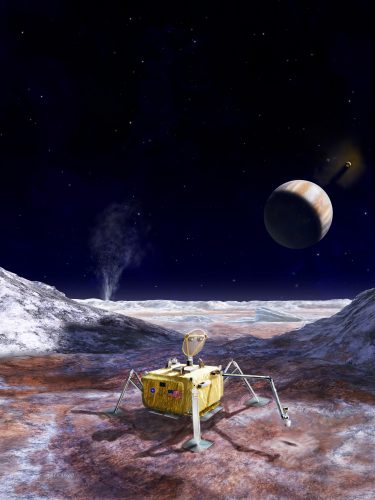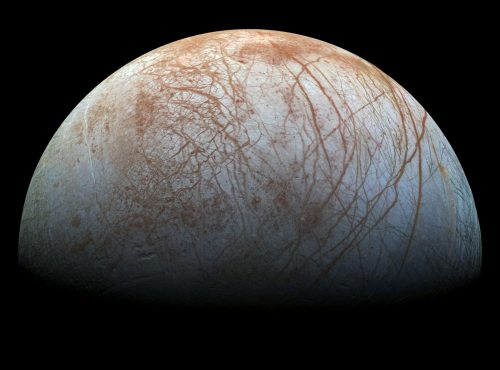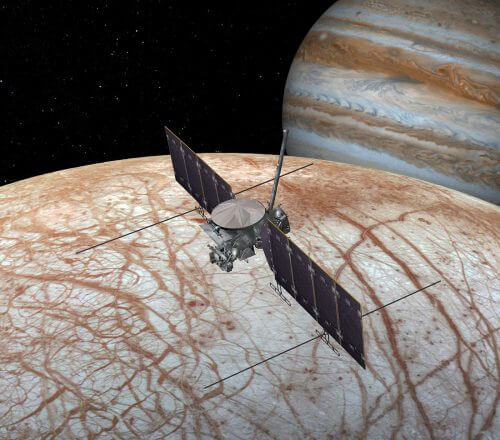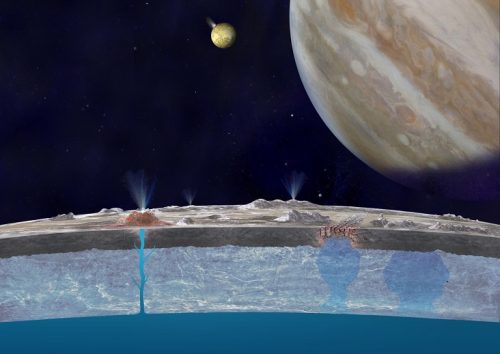NASA is considering launching a lander in the next decade to Jupiter's moon Europa, which is believed to have a global ocean beneath its outer ice sheet that may be suitable for life. If the mission is approved, it will be the first time that NASA will send a mission to directly search for life in the solar system, since the Viking landings on Mars in the 70s. The proposed lander will operate separately to another NASA mission that has already been approved and is currently being developed, to launch a probe that will explore the moon Europa from orbit around Jupiter.

Last week, NASA published a report on the goals and characteristics of a mission that the agency is considering developing, in which a vehicle will be launched to land on Jupiter's moon Europa and search for life or signs of life on the moon. Europa is one of the most interesting places in the solar system today, because researchers estimate that beneath its outer ice sheet there exists a vast ocean of liquid, salty water that may allow life to exist there.
NASA has been developing another mission for Europe for several years - a probe that will enter orbit around Jupiter and make a large number of flybys near the moon. It will try to prove beyond any doubt that the subglacial ocean does exist and examine whether the conditions suitable for life exist there. The probe will fly close to the moon and will not enter orbit around it because of the intense radiation near Jupiter, which will destroy its electronic components very quickly. According to the current plan, the probe, which does not yet have an official name and is called the Europa multiple flyby mission (EMFM for short), will be launched around the year 2022.
The current lander proposal comes after the agency received an explicit directive from the US Congress, in the 2016 NASA Budget Act, to develop a lander mission to Europe. Although according to The wording of the law The lander was supposed to be included as part of the EMFM probe mission, but according to the proposal detailed in the report, the lander will operate as a completely separate mission from the probe - it will be launched separately and will include its own spacecraft that will enter orbit around Europa and serve as a relay station between the lander and Earth.

One of the main goals of the proposed lander will be to directly search for life, or chemical signs that indicate the existence of life on the moon. If approved, it will be the first time NASA has sent a mission with the goal of directly searching for life since the Viking landers on Mars in the 70s. In the case of Mars, the landings did not produce clear results, and since then the agency has avoided carrying out missions with the direct goal of searching for life, but with more indirect goals, such as examining the conditions in Mars' early past and whether they were suitable for life.
To search for life, the lander will use a robotic arm to collect samples from a depth of up to 10 centimeters below Europa's outer ice sheet, and will put them into a laboratory that will analyze their chemical composition, and will also include a microscopic system that will be able to detect bacteria as small as 0.2 microns. The lander will also be equipped with stereo cameras, a seismograph and other scientific instruments to explore the moon.
Even if the lander does not send us the long-awaited image of an extraterrestrial bacterium, or other less direct signs of life on Europa, the mission will make it possible to directly examine, in situ, whether the right conditions exist for life in Europa, and especially in its sub-glacial ocean, and pave the way for research More detailed of the moon in the future.

Europa has been known as an interesting and unusual moon for decades, ever since it was imaged by the Voyager spacecraft in the late 70s. Almost no craters are visible on its surface, which indicates its relatively young age from a geological point of view. On the other hand, its surface is scarred with many cracks and bands that cut each other, some of them extending over tens of kilometers. The researchers estimate that they are caused by the displacement of the ice in the outer layer.
From this terrain and other data, researchers concluded that there may be a liquid ocean under the outer ice layer. The most important evidence The existence of the sub-ice ocean came from the Galileo spacecraft, which studied Jupiter and its moons between 1995-2003. She discovered that the moon has a weak magnetic field created by the influence of Jupiter's magnetic field, and the most plausible explanation is that this magnetic field is created by an electrically conductive layer of salty liquid water at a depth of up to 100 km, which is under an outer layer of ice at a height of about 10 -30 km. If it does exist, this ocean contains more water than all the oceans on Earth.
In recent years observations from the Hubble Space Telescope They showed That it is possible that jets of water vapor come out like geysers from the surface of Europa. Although the observations made by the telescope are inconclusive, it is known that such jets exist on the moon Enceladus of Saturn, and they Were observed by the Cassini spacecraft that studies Saturn and its moons. It is estimated that these water jets on Enceladus originate from the sub-ice ocean that also exists on Enceladus. If such jets also exist in Europe, they will provide a golden opportunity to examine the chemical composition of Europa's sub-ice ocean, without having to drill through its thick ice sheet.
If approved, the researchers' hope is that the EMFM probe, which will arrive several years before the lander and provide photographs with a much higher resolution than that provided by Galileo, will make it possible to find ideal landing sites for the lander, both in terms of landing safety and in terms of scientific interest.

According to the proposal, the lander will be launched between 2024-2025 together with its own "mother spacecraft", which will navigate the journey to Jupiter. It will assist in flying close to the Earth andTake advantage of its gravity to increase its speed to the speed required to reach justice. Upon arrival at Jupiter, after a journey of about five years, it will use the same method of close flybys, this time near Jupiter's large moons, to slow its speed and enter orbit around the moon Europa.
Upon entering lunar orbit, the lander will be released from its mother spacecraft and begin the complicated process of landing. Since the moon has no atmosphere, the only way to land on it is with rocket engines. Its surface is complicated and not smooth, and an imprecise landing may end in failure. Therefore, the report suggests using the "sky crane" method, which successfully landed the Curiosity rover on Mars in 2012. In this method, the rocket engines of the landing system will stop the lander at a certain height above the ground and it will land using a cable that will carefully dangle it down.
The moon Europa is the second closest to Jupiter of the planet's large moons, and lies deep within the region of Jupiter's intense radiation belts, which are created by its enormous magnetic field. Therefore, upon entering orbit around Europa, the lander and its mother spacecraft will have a very limited time until the strong radiation destroys their electronic components. For this reason, the lander will not have a renewable energy source, and it will operate on batteries that will last for between 20 and 40 days of activity only.

The proposal may fulfill the wet dream of NASA researchers and astrobiological scientists looking for extraterrestrial life, but it is not clear how realistic it is from a budgetary point of view. The report did not mention at all what the cost of the task would be. In addition to this, the report suggests launching the lander and its mother spacecraft on top SLS launcher, a heavy launcher that NASA is currently developing to launch astronauts into orbit around the moon and possibly to Mars in the future. The cost of one SLS launcher is estimated at about $XNUMX billion, so if we add that to the cost of an innovative mission like the proposed lander, it's clear that such a mission would cost a fortune.
Whether the proposal in the report is approved in the current outline or a more modest one, there is no doubt that the moon Europa stands at the front of the queue of research targets in the solar system for the American space agency, and in fact not only for it. The European Space Agency plans to launch the probe in 2022 JUICE, which will explore Europa, along with Jupiter's two other large icy moons, Callisto and Ganymede.

3 תגובות
"ALL THESE WORLDS ARE YOURS - EXCEPT EUROPE. ATTEMPT NO LANDINGS THERE”
The monolith warns us in the 2010 book/movie Space Odyssey
Finally got some sense